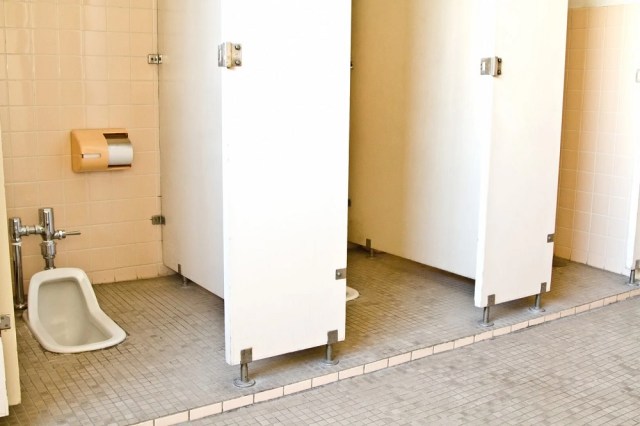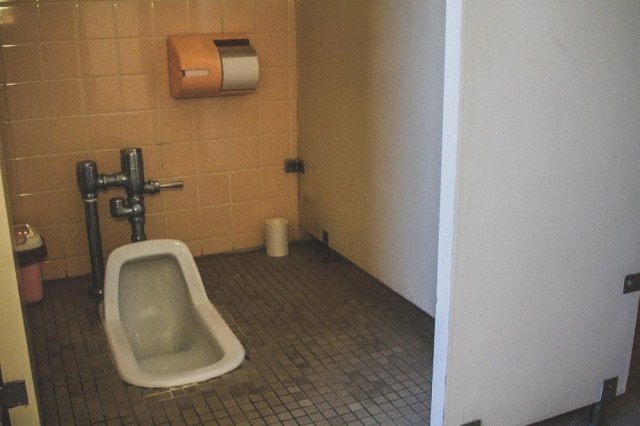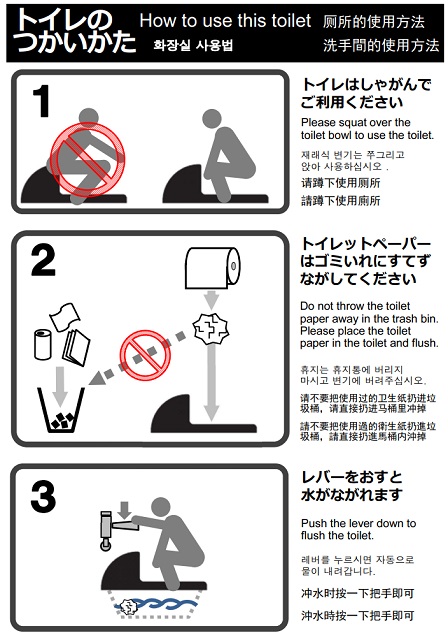
Public restroom trash containers overflowing with used wiping papers also a problem.
This summer was the first since Japan fully reopened to international tourism. That resulted in a big spike in visitors from abroad coming to the country to experience Japanese culture, enjoy Japanese food…and be confused by Japanese toilets.
Miyama Kayabuki no Sato is a village in Kyoto Prefecture, to the north of Kyoto City, with a collection of preserved traditional farmhouses and a museum detailing how daily life was for past generations who lived in this bucolic community. Kayabuki no Sato, which is part of Natan City, welcomes visitors from overseas, but in recent months they’ve been having problems with how some of those visitors are using one of the town’s public restrooms, which is located near the parking lot for tour busses. Yoshifumi Nakano, head of the Kayabuki no Sato Preservation Society, thinks that the trouble stems from overseas visitors being unfamiliar with multiple aspects of how Japanese-style toilets are meant to be used, leading to poo on the floor and overflowing trash containers.
Out of the 12 restroom stalls at this restroom, eight of them have Japanese-style toilets, similar in design to the one shown in the photo above. For some visitors coming from countries that have no squat-style toilets, their natural tendency may be to use the Japanese-style toilet in as close a manner as they can to a Western-style one: they step into the stall, close the door, then do their business while facing the front door, and with their hindquarters facing towards the toilet, with some apparently even lightly resting their buttocks on the tip of the raised half-dome like it’s a toilet seat.
This is, though, the opposite of how you’re supposed to situate yourself. Having your butt hovering near the dome increases the chance that your droppings will drop onto the top of the dome, from where it’ll slide down to the bathroom floor. To help prevent this, the proper way to took a dump in a Japanese-style toilet it to face the toilet itself, scooching up close to the dome and also using it as a guide to make sure you’ve got your anus laterally lined up so that your deposits will land in the bowl and can be flushed away.
Inaccurate deuce-dropping isn’t the only problem Kayabuki no Sato is grappling with these days, though. Nakano says that the trash containers inside the village’s restrooms stalls are sometimes overflowing with feces-streaked paper after international tour buses come through.
As seen in the example photo above, many Japanese bathrooms have a small lidded trash container located inside the stall and within arm’s reach of the toilet. For visitors from countries where the sewage system doesn’t have the capacity for paper and wet wipes to flow through the pipes, this container might look like where you’re supposed to stick your paper after you wipe your butt, as is the case in many parts of southeast Asia.
However, in Japan that’s not what these containers are there for. The Japanese sewage system has no trouble flowing toilet paper, and these in-stall trash containers are primarily meant as receptacles for used feminine hygiene products. That’s why you typically only see these trash containers in women’s or mixed-use stalls, and also why the containers aren’t very big. With overseas visitors to Kayabuki no Sato putting used wiping paper in there, though, that’s a much larger volume of trash, to the point where Nakano says that the parking lot administrative staff has had to start emptying the containers because they’re filling up and overflowing by the time of the cleaning staff’s next pass through the restrooms.
None of this should be taken to mean that Kayabuki no Sato doesn’t want foreign visitors. Still, poo staining the floor and spilling out of wastebaskets is a problem, especially for a country that prides itself on cleanliness as much as Japan does. The three other public restrooms in the village have already been converted to all-Western-style toilets, and Nakano says the plan is to convert the eight Japanese-style toilets at the parking lot restroom to Western-style units as well. That’s going to take time, though, so in the meantime Nakano is hoping that increased awareness will help improve the situation.
Kyoto City itself has been dealing with similar issues for some time, and last year the municipal government designed and released an explanatory graphic with text in Japanese, English, Korean, and both traditional and simplified Chinese explaining the correct way to use a Japanese-style toilet and what to do with used toilet paper. Adding a few such posters or stickers to the stall interiors at Kayabuki no Sato might be the best plan during the transitionary period to help remind people that when in Rome, one should poop as the Romans do.
Related: Kayabuki no Sato official website
Sources: J-Cast News via Livedoor News via Jin, Kyoto City
Top image: PR Times
Insert images: Pakutaso (1, 2), Kyoto City
● Want to hear about SoraNews24’s latest articles as soon as they’re published? Follow us on Facebook and Twitter!




 Use this Japanese-style toilet properly, or else “you are gonna fall down on s***”
Use this Japanese-style toilet properly, or else “you are gonna fall down on s***” Poll reveals what we already know: Japanese toilets make no sense, confuse us all
Poll reveals what we already know: Japanese toilets make no sense, confuse us all 12 toilet oddities around the world that surprise Japan
12 toilet oddities around the world that surprise Japan Recent Survey Reveals Over 60% of Japanese Elementary Students Hate Japanese Style Toilets, Who Can Blame Them?
Recent Survey Reveals Over 60% of Japanese Elementary Students Hate Japanese Style Toilets, Who Can Blame Them? Reactions to video showing how awesome Japanese toilet paper holders are leave us laughing 【Vid】
Reactions to video showing how awesome Japanese toilet paper holders are leave us laughing 【Vid】 Japanese beef bowl chain Sukiya’s 2026 Smile Box lucky bag basically pays for itself
Japanese beef bowl chain Sukiya’s 2026 Smile Box lucky bag basically pays for itself Starbucks Japan ready to get Year of the Horse started with adorable drinkware and plushies【Pics】
Starbucks Japan ready to get Year of the Horse started with adorable drinkware and plushies【Pics】 Sega’s Like a Dragon yakuza teaches “useless” English, let’s use it to learn some useful Japanese
Sega’s Like a Dragon yakuza teaches “useless” English, let’s use it to learn some useful Japanese Japanese thug wear from Birth Japan perfect for those breaking bad next year
Japanese thug wear from Birth Japan perfect for those breaking bad next year Studio Ghibli retailer now sells Japanese anime curry with all the special utensils
Studio Ghibli retailer now sells Japanese anime curry with all the special utensils Adorable Kirby merchandise gets special launch party with custom-made Kirby cupcakes! 【Pics】
Adorable Kirby merchandise gets special launch party with custom-made Kirby cupcakes! 【Pics】 Japanese schoolgirls’ hemlines are still up, but socklines are way down
Japanese schoolgirls’ hemlines are still up, but socklines are way down Dragon Quest Burgers and Slime drinks are coming to McDonald’s Japan【Video】
Dragon Quest Burgers and Slime drinks are coming to McDonald’s Japan【Video】 Princesses, fruits, and blacksmiths: Study reveals the 30 most unusual family names in Japan
Princesses, fruits, and blacksmiths: Study reveals the 30 most unusual family names in Japan Meet Issie, Japan’s very own Loch Ness Monster
Meet Issie, Japan’s very own Loch Ness Monster Hayao Miyazaki says Happy New Year to Studio Ghibli fans with new art for Year of the Horse
Hayao Miyazaki says Happy New Year to Studio Ghibli fans with new art for Year of the Horse 7 great places to see Mt. Fuji from without having to climb it
7 great places to see Mt. Fuji from without having to climb it We found possibly the quietest Japanese-style hotel in Tokyo’s bustling Shinjuku district
We found possibly the quietest Japanese-style hotel in Tokyo’s bustling Shinjuku district Cup Noodle tries an authentic Jiro-style ramen, but something’s not quite right
Cup Noodle tries an authentic Jiro-style ramen, but something’s not quite right Hello Kitty Choco Egg figures are an adorable trip through three periods of Japanese pop culture【Pics】
Hello Kitty Choco Egg figures are an adorable trip through three periods of Japanese pop culture【Pics】 Japan’s oldest largetooth sawfish in captivity back on display in Mie Prefecture
Japan’s oldest largetooth sawfish in captivity back on display in Mie Prefecture Cyberpunk anime meets traditional culture in Ghost in the Shell gold leaf Japanese changing screens
Cyberpunk anime meets traditional culture in Ghost in the Shell gold leaf Japanese changing screens The best Starbucks Japan Frappuccinos we want to drink again in 2026
The best Starbucks Japan Frappuccinos we want to drink again in 2026 We revisited Sweets Paradise after a decade to see if Japan’s dessert buffet still delivers
We revisited Sweets Paradise after a decade to see if Japan’s dessert buffet still delivers 7-Eleven Japan starts new temporary luggage storage service in over 300 branches
7-Eleven Japan starts new temporary luggage storage service in over 300 branches Disillusionment at Tsukiji’s tourist-target prices led us to a great ramen restaurant in Tokyo
Disillusionment at Tsukiji’s tourist-target prices led us to a great ramen restaurant in Tokyo Starbucks teams up with 166-year-old Kyoto doll maker for Year of the Horse decorations【Photos】
Starbucks teams up with 166-year-old Kyoto doll maker for Year of the Horse decorations【Photos】 Tokyo considering law requiring more trash cans following litter increase in heavily touristed area
Tokyo considering law requiring more trash cans following litter increase in heavily touristed area Tokyo’s Tsukiji sushi neighborhood asks tour groups to stay away for the rest of the month
Tokyo’s Tsukiji sushi neighborhood asks tour groups to stay away for the rest of the month Tokyo event lets you travel back in time, for free, to celebrate 100 years since Showa era start
Tokyo event lets you travel back in time, for free, to celebrate 100 years since Showa era start Sanrio theme park in Japan announces plans to expand into a Sanrio resort
Sanrio theme park in Japan announces plans to expand into a Sanrio resort Japan may add Japanese language proficiency, lifestyle classes to permanent foreign resident requirements
Japan may add Japanese language proficiency, lifestyle classes to permanent foreign resident requirements Stamina-destroying “Paralysis Noodles” are Tokyo’s newest over-the-top ramen innovation
Stamina-destroying “Paralysis Noodles” are Tokyo’s newest over-the-top ramen innovation Survey asks foreign tourists what bothered them in Japan, more than half gave same answer
Survey asks foreign tourists what bothered them in Japan, more than half gave same answer Japan’s human washing machines will go on sale to general public, demos to be held in Tokyo
Japan’s human washing machines will go on sale to general public, demos to be held in Tokyo Japan’s deadliest food claims more victims, but why do people keep eating it for New Year’s?
Japan’s deadliest food claims more victims, but why do people keep eating it for New Year’s? We deeply regret going into this tunnel on our walk in the mountains of Japan
We deeply regret going into this tunnel on our walk in the mountains of Japan Studio Ghibli releases Kodama forest spirits from Princess Mononoke to light up your home
Studio Ghibli releases Kodama forest spirits from Princess Mononoke to light up your home Major Japanese hotel chain says reservations via overseas booking sites may not be valid
Major Japanese hotel chain says reservations via overseas booking sites may not be valid Put sesame oil in your coffee? Japanese maker says it’s the best way to start your day【Taste test】
Put sesame oil in your coffee? Japanese maker says it’s the best way to start your day【Taste test】 No more using real katana for tourism activities, Japan’s National Police Agency says
No more using real katana for tourism activities, Japan’s National Police Agency says Starbucks Japan reveals new sakura drinkware collection, inspired by evening cherry blossoms
Starbucks Japan reveals new sakura drinkware collection, inspired by evening cherry blossoms Updated cherry blossom forecast shows extra-long sakura season for Japan this year
Updated cherry blossom forecast shows extra-long sakura season for Japan this year New Japanese toilet paper dispenser tears off sheets, folds the ends into a point for you【Video】
New Japanese toilet paper dispenser tears off sheets, folds the ends into a point for you【Video】 Turns out even Japanese people aren’t sure how to use Japanese-style toilets
Turns out even Japanese people aren’t sure how to use Japanese-style toilets Squat toilets’ popularity fading as parents call for them to be abolished in Japanese schools
Squat toilets’ popularity fading as parents call for them to be abolished in Japanese schools Japanese defecation survey says kids struggle with Japanese toilets, contributing to constipation
Japanese defecation survey says kids struggle with Japanese toilets, contributing to constipation Japanese public toilet tours become popular with foreign tourists in Tokyo
Japanese public toilet tours become popular with foreign tourists in Tokyo Foreign tourists pick the top 10 inconveniences about traveling in Japan【Survey】
Foreign tourists pick the top 10 inconveniences about traveling in Japan【Survey】 Japanese squat toilet plastic model kit: Weird, gross, or both?【Photos】
Japanese squat toilet plastic model kit: Weird, gross, or both?【Photos】 Japanese public toilet in Tokyo has windows that change colour when you use it
Japanese public toilet in Tokyo has windows that change colour when you use it Japanese travelers are avoiding Kyoto as the city’s number of foreign visitors continues to grow
Japanese travelers are avoiding Kyoto as the city’s number of foreign visitors continues to grow Japanese public toilet in Tokyo is more like a fancy restaurant than a restroom
Japanese public toilet in Tokyo is more like a fancy restaurant than a restroom Kyoto merchants want city to install more trash cans to fight litter in historic neighborhood
Kyoto merchants want city to install more trash cans to fight litter in historic neighborhood Golden Japanese toilet appears at “multi-millionaire” izakaya in Tokyo
Golden Japanese toilet appears at “multi-millionaire” izakaya in Tokyo Kyoto study finds nearly 500 translation errors for foreign tourists, new guidelines released
Kyoto study finds nearly 500 translation errors for foreign tourists, new guidelines released As more foreign visitors visit Kyoto’s top sights, Japanese travelers increasingly staying away
As more foreign visitors visit Kyoto’s top sights, Japanese travelers increasingly staying away Foreign travelers’ lukewarm reactions to traditional Japanese inn food causing changes in Kyoto
Foreign travelers’ lukewarm reactions to traditional Japanese inn food causing changes in Kyoto Japanese manners videos show how to be a “really cool” traveller in Japan 【Videos】
Japanese manners videos show how to be a “really cool” traveller in Japan 【Videos】
Leave a Reply